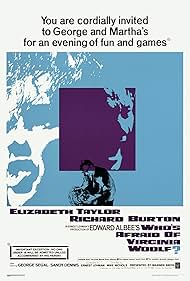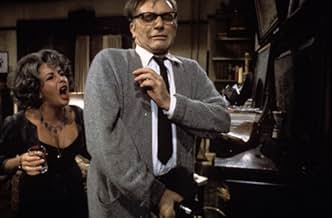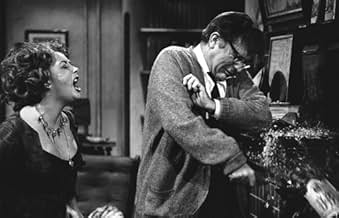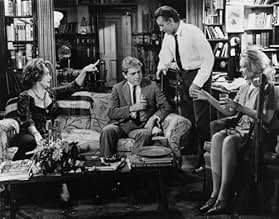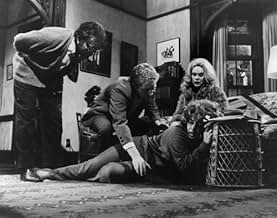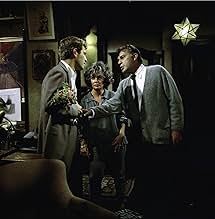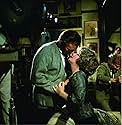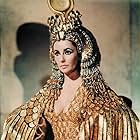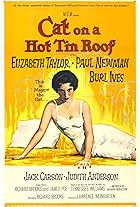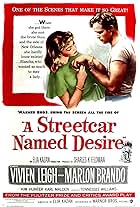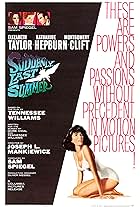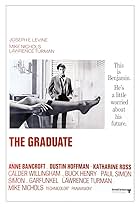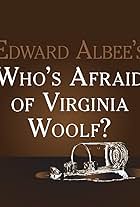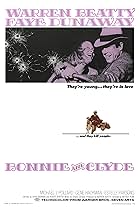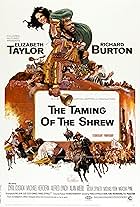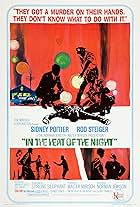Un couple amer et vieillissant, l'alcool aidant, se sert d'un jeune couple pour alimenter l'angoisse et la douleur émotionnelle qu'ils ressentent l'un envers l'autre.Un couple amer et vieillissant, l'alcool aidant, se sert d'un jeune couple pour alimenter l'angoisse et la douleur émotionnelle qu'ils ressentent l'un envers l'autre.Un couple amer et vieillissant, l'alcool aidant, se sert d'un jeune couple pour alimenter l'angoisse et la douleur émotionnelle qu'ils ressentent l'un envers l'autre.
- A remporté 5 oscars
- 22 victoires et 26 nominations au total
Histoire
Le saviez-vous
- AnecdotesThis became the first movie in Academy Awards history since La Ruée vers l'Ouest (1931) to be nominated for every Academy Award category in which it was eligible, including Best Adapted Screenplay (Ernest Lehman), Director (Mike Nichols), all of the acting categories (Richard Burton, Dame Elizabeth Taylor, George Segal and Sandy Dennis) and Picture of the Year (Ernest Lehman).
- GaffesThe four characters stop at a bar after the first soiree at George's house. It is clearly after 2:00 a.m., since the time was stated during the first segment. No bars, however, would have been open after 1 or 2 a.m. in the New England states, where the film is set.
- ConnexionsEdited from The Letter (1940)
- Bandes originalesWho's Afraid of Virginia Woolf?
(to the tune of "Here We Go Round the Mulberry Bush")
Traditional English melody
Original lyrics ("Who's Afraid of the Big Bad Wolf?") by Frank Churchill and Ann Ronell; modified by Edward Albee
Performed by Elizabeth Taylor
Commentaire en vedette
WHOS's AFRAID OF VIRGINIA WOOLF? is a drama film with the elements of black comedy, that on the violent and honest way indicates marital frustration and psyche, through the alcoholism, aging, cynicism and sterility. A dangerous double game becomes more intense and urgency with environmental changes. Simply, we are going through an intimate experience, which is seasoned with an excellent acting. The problem occurs in the moment, when we realize, how much is this experience, as a matter of fact, sincere and painful.
George, an associate history professor at a small New England college, and Martha, the daughter of the university president, live in an unstable and violent marriage. After they return home drunk from a party, Martha reveals she has invited a young married couple, whom she'd met at the party, for a drink. Their guests are Nick, a biology professor, and his wife, Honey. The hosts are engaged in a cruel verbal duel. The younger couple is first embarrassed and later enmeshed. After an evening of a sadistic, perversely hilarious and dangerous clashes", a painful truth comes to the light.
Mr. Nichols keeping his camera close, so that, violent emotions, defeats and cramps on the faces of the actors come to the fore. The direction is excellent, because it is very difficult to draw the line between passion borders and boundaries of a nervous breakdown. The characters are lost in a futile and desperate struggle, which celebrates a kind of demonic love in an attempt to save a bad marriage.
The characterization is excellent and fully corresponds with sharp dialogues and gloomy atmosphere.
Elizabeth Taylor as Martha is definitely a major figure in this film with her acceptance of gray hair and her use of profanity. It is difficult to accept that such a beautiful face hides a violent and so crazed but again, fragile and deeply wounded character. Richard Burton as George is worthy as a her counterweight. He is not a victim, he is the husband who is tired of everything, while he tries to put all the things in the right place. The couple has offered an excellent performance.
George Segal as Nick is a young man who moves between confusion, arrogance and dominance in their relations. Sandy Dennis as Honey is his bland wife. She is not up to this unscrupulous game.
This is a brutal clash between unhappy spouses who move the boundaries of inhumanity, while they skillfully flee from the truth.
George, an associate history professor at a small New England college, and Martha, the daughter of the university president, live in an unstable and violent marriage. After they return home drunk from a party, Martha reveals she has invited a young married couple, whom she'd met at the party, for a drink. Their guests are Nick, a biology professor, and his wife, Honey. The hosts are engaged in a cruel verbal duel. The younger couple is first embarrassed and later enmeshed. After an evening of a sadistic, perversely hilarious and dangerous clashes", a painful truth comes to the light.
Mr. Nichols keeping his camera close, so that, violent emotions, defeats and cramps on the faces of the actors come to the fore. The direction is excellent, because it is very difficult to draw the line between passion borders and boundaries of a nervous breakdown. The characters are lost in a futile and desperate struggle, which celebrates a kind of demonic love in an attempt to save a bad marriage.
The characterization is excellent and fully corresponds with sharp dialogues and gloomy atmosphere.
Elizabeth Taylor as Martha is definitely a major figure in this film with her acceptance of gray hair and her use of profanity. It is difficult to accept that such a beautiful face hides a violent and so crazed but again, fragile and deeply wounded character. Richard Burton as George is worthy as a her counterweight. He is not a victim, he is the husband who is tired of everything, while he tries to put all the things in the right place. The couple has offered an excellent performance.
George Segal as Nick is a young man who moves between confusion, arrogance and dominance in their relations. Sandy Dennis as Honey is his bland wife. She is not up to this unscrupulous game.
This is a brutal clash between unhappy spouses who move the boundaries of inhumanity, while they skillfully flee from the truth.
- elvircorhodzic
- 27 oct. 2017
- Lien permanent
Meilleurs choix
Connectez-vous pour évaluer et surveiller les recommandations personnalisées
Détails
- Date de sortie
- Pays d’origine
- Langues
- Aussi connu sous le nom de
- Who's Afraid of Virginia Woolf?
- Lieux de tournage
- Cambridge, Massachusetts, États-Unis(location)
- sociétés de production
- Consultez plus de crédits d'entreprise sur IMDbPro
Box-office
- Budget
- 7 500 000 $ US (estimation)
- Brut – États-Unis et Canada
- 28 000 000 $ US
- Brut – à l'échelle mondiale
- 28 006 929 $ US
- Durée2 heures 11 minutes
- Couleur
- Mixage
- Rapport de forme
- 1.85 : 1
Contribuer à cette page
Suggérer une modification ou ajouter du contenu manquant

Lacune principale
By what name was Qui a peur de Virginia Woolf? (1966) officially released in India in English?
Répondre